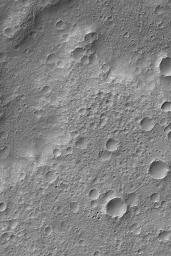Heavily Cratered Surfaces
Caption:
2 November 2004
When it comes to planetary surfaces, the more craters there are, the older the terrain is believed to be. However, because the martian surface has experienced considerable episodes of erosion as well as burial of craters, a surface covered with many small craters on Mars is often one that is more resistant to erosion, not necessarily one that is older than a less-cratered surface. This Mars Global Surveyor (MGS) Mars Orbiter Camera (MOC) image shows an example of an extremely cratered surface. This can be contrasted with nearly any of the exposures of martian sedimentary rock, which are very old but do not retain as many craters because they are more easily eroded. Hundreds of examples of martian sedimentary rock outcrops are listed in the
MOC Captioned Release, Sedimentary Rocks
gallery. This image is located near 33.6°S, 204.7°W. The picture covers an area about 3 km (1.9 mi) wide. Sunlight illuminates the scene from the upper left.
Cataloging Keywords:
| Name |
Value |
Additional Values |
| Target |
Mars |
|
| System |
|
|
| Target Type |
Planet |
|
| Mission |
Mars Global Surveyor (MGS) |
|
| Instrument Host |
Mars Global Surveyor |
|
| Host Type |
Orbiter |
|
| Instrument |
Mars Orbiter Camera (MOC) |
|
| Detector |
|
|
| Extra Keywords |
Crater, Grayscale |
| Acquisition Date |
|
| Release Date |
2004-11-02 |
| Date in Caption |
2004-11-02 |
|
| Image Credit |
NASA/JPL/Malin Space Science Systems |
| Source |
photojournal.jpl.nasa.gov/catalog/PIA06979 |
| Identifier |
PIA06979 |

